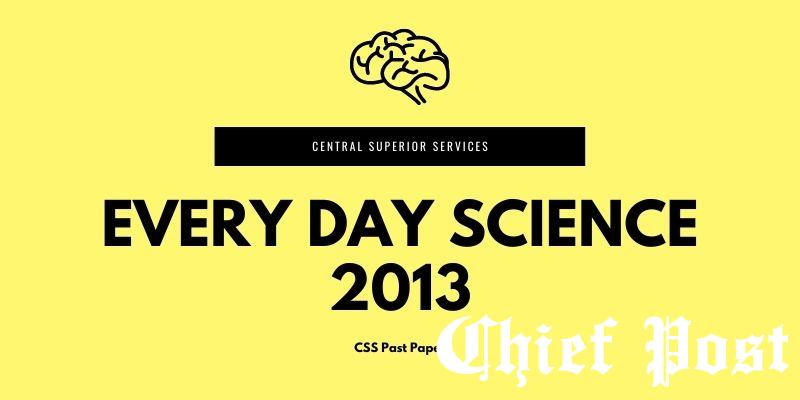
Every Day Science 2013 — CSS Past Paper
FEDERAL PUBLIC SERVICE COMMISSION
COMPETITIVE EXAMINATION FOR
RECRUITMENT TO POSTS IN BS-17
UNDER THE FEDERAL GOVERNMENT, 2013
Q. No. 2. Discuss the contribution of Muslim scientists in the development of Astronomy,
Algebra and Trigonometry. (3, 31/2, 31/2 each)
(10)
Q. No. 3. Give brief answers to the following questions: (2 each)
(a) Why do we bring our hands close to our mouth while shouting across to
someone far away?
(b) Why do we lean forward while climbing a hill?
(c) Why does a swimming pool appear less deep than it actually is?
(d) Why cannot petrol fire be extinguished by water?
(e) Why do Australians celebrate their Christmas during summer?
(10)
Q. No. 4. Differentiate between: (2 each)
(a) Hypoglycemia and Hyperglycemia
(b) Renewable and Non-renewable energy resources
(c) Lava and Magma (d) Mist and Fog (e) Lunar Eclipse and Solar Eclipse
(10)
Q. No. 5. Briefly explain the working principle of the following: (5 each)
(a) Radar (b) Microwave Oven
(10)
Q. No. 6. Give brief explanations for following phenomena: (2 each)
(a) While watching a cricket match we see the ball struck a moment before we
hear the sound of the bat hitting the ball.
(b) A ship though made largely of steel, which is heavier than water, floats in
water.
(c) The colour of the same cloth when seen in electric light appears different from
the colour when seen in day light.
(d) Glass when heated cracks while metal does not.
(e) Although each eye perceives a separate image, we do not see everything
double.
(10)
Q. No. 7. Write short NOTES on the following: (5 each)
(a) Environmental effects of Fertilizer use. (b) Global Warming.
(10)
Q. No. 8. Differentiate between: (2 each)
(a) Smog and Smoke (b) Radiotherapy and Chemotherapy
(c) Diastolic and Systolic blood pressure (d) Infection and Allergy
(e) Conductors and Insulators
(10)
Q. No. 9. Briefly explain the function of following in human body: (21/2 each)
(a) Kidneys (b) Lymphatic system
(c) Thyroid gland (d) Pituitary gland
- The unit to measure the quantity of Ozone in the atmosphere is:
(a) Dobson (b) Dalton (c) Coulomb (d) None of these - The severity of 2005 earthquake of Pakistan on Richter Scale was:
(a) 6.9 (b) 7.6 (c) 7.1 (d) None of these - Geiger-Muller Counter is used to detect:
(a) Protons (b) Neutrons (c) Photons (d) None of these - Vacuum tubes have been replaced by:
(a) Conductors (b) Diodes (c) Transistors (d) None of these - Dacron is:
(a) Polyethylene (b) Epoxy (c) Polyamide (d) None of these - It is a secondary plant nutrient:
(a) Nitrogen (b) Phosphorus (c) Sulphur (d) None of these - An area of microbiology that is concerned with the occurrence of disease in human population is:
(a) Immunology (b) Parasitology (c) Epidemiology (d) None of these - The number of electrons of a neutral atom is automatically known if one knows the:
(a) Atomic number (b) Atomic weight (c) Number of orbitals (d) None of these - Which of the following is not an enzyme?
(a) Chymotrypsin (b) Secretin (c) Pepsin (d) None of these - It is impossible for a type O+ baby to have a type________ mother.
(a) AB-
(b) O- (c) O+
(d) None of these - Serum is blood plasma minus its:
(a) Calcium ions (b) Clotting proteins (c) Globulins (d) None of these - The autonomic nervous system innervates all of these except:
(a) Cardiac muscles (b) Skeletal muscles (c) Smooth muscles (d) None of these - The damage to the _ nerve could result in the defect of the eye movement:
(a) Optic (b) Trigeminal (c) Abducens (d) None of these - Which of these is not a region of the spinal cord?
(a) Thoracic (b) Pelvic (c) Lumbar (d) None of these - The shape of the external ear is due to:
(a) Elastic cartilage (b) Fibrocartilage (c) Articular cartilage (d) None of these - The external surface of the stomach is covered by:
(a) Mucosa (b) Serosa (c) Parietal peritoneum (d) None of these - Which of the following is not a human organ system?
(a) Integumentary (b) Muscular (c) Epithelial (d) None of these - Which of the following does not vary predictably with the depth of the aquatic environment?
(a) Salinity (b) Temperature (c) Penetration by sunlight (d) None of these - The quantity of available nutrients _________from the lower levels of the energy pyramids to the higher ones.
(a) Increases (b) Decreases (c) Remains stable (d) None of these - Which of the following is not a major subdivision of the biosphere?
(a) Hydrosphere (b) Lithosphere (c) Stratosphere (d) None of these - Vaccination is synonymous with __________immunity.
(a) Natural active (b) Artificial passive (c) Artificial active (d) None of these - When a patient’s immune system becomes reactive to a drug, this is an example of:
(a) Superinfection (b) Drug resistance (c) Allergy (d) None of these - What is the smallest unit of heredity?
(a) Chromosomes (b) Gene (c) Nucleotide (d) None of these
PART-II
NOTE:(i) Part-II is to be attempted on the separate Answer Book.
(ii) Candidate must write Q. No. in the Answer Book in accordance with Q. No. in the Q. Paper.
(iii) Attempt ONLY FIVE questions from PART-II. ALL questions carry EQUAL marks.
(iv) Extra attempt of any question or any part of the attempted question will not be considered.
Q.No.2. (a) “The flood disaster in Pakistan is caused by the follies of humans “. Comment.
(b) State the message of “The Earth Hour Movement”.
(05)
(05)
Q.No.3. (a) Porifera is an ancient group of animals from Cambrian period. What is the cause of their survival /success?
(b) How heavy water differs from ordinary water and what is its use in the Atomic Reactor?
(05)
(05)
Q.No.4. What part do antibodies play in allergic reactions? How vaccination can be helpful in its control/ prevention? (10)
Q.No.5. (a) Differentiate between Renewable and Non-renewable sources of energy. Give examples of each one of them.
(b) Why Nuclear Energy is being preferred in developed countries and why are we lagging behind in this
important source of energy?
(05)
(05)
Q.No.6. (a) What is Nanotechnology and what are its uses?
(b) Briefly explain the differences between Chemotherapy and Radiotherapy.
(05)
(05)
Q.No.7. Write comprehensive notes on:
(a) LASER and their uses. (b) OPTIC FIBRES and their importance in modern telecom system. (5 each)
Q.No.8. Write all that you know about Pesticides. How are they classified by agronomists? (10)
Q.No.9. Write note on: (a) Biotechnology (b) Global Warming (5 each)










